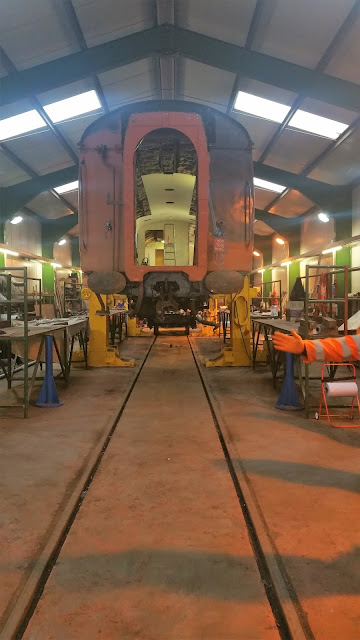Following on from the successful fitting of the water tanks, the floor could finally be replaced and fixed in place.
The picture below shows the floor in the bar area.
The floor in the kitchen, pictured below has also been fitted in place.
This view shows the additional battens in the roof above the bar. This is where the glass rack will be fitted. Also in the picture is the first ceiling panel to be fitted in place.
Look no wheels, it almost looks like levitation, as pointed out by my arm in the picture. The coach has been lifted into the air ready for the bogies. Inside the coach the new ceiling panels can be seen, the first three have been put into place.
The bogies being rolled into place under the coach.
Lowering the coach onto the bogie. Watching for the centre pin to engage properly with the bogie bolster plank.
The bogies have been placed under the coach to enable the drop links and support beam to be fitted under the bolster. This involves using the weight of the vehicle to jack the bolster upwards against it. This squeezes the springs together allowing the support beam to be put into place. The bogies will have to come out again later to complete the brake components and fit the safety straps.
These tubes are like track control arms. They ensure that the bolster plank stays central in the bogie. They have rubber bushes at each end with steel washers acting as spacers. all of these parts had to be replaced as they were all life expired.
This picture also shows the drop arms with the support beam in place under the bottom bolster plank. This via the spring nests supports the top bolster plank on which the coach body sits.
Some of the rubber bushes that we had to have specially made.
An attempt to document the activities of the Strathspey railway Carriage and wagon department
Sunday, 11 November 2018
Monday, 5 November 2018
Latest news, water tank work
Apart from a broken window on mark 1, TSO 5057, work has concentrated on the water tanks from RU, 1936.
The tanks were removed for two reasons. firstly the cladding surrounding the tanks was corroding and the insulation was leaking out. Secondly the interior had debris inside which looked like rust particles, the composition of the tanks had to be checked to find the source.
The insulation material was tested and found to not contain anything nasty, so we proceeded to remove this. Pictured below are the cleaned up tanks, which are of a copper construction.
The rust was found to have come from the filler pipes. Two mild steel collars had been fitted which had rusted, these are being replaced by brass fittings.
The tanks were covered with insulation about 12mm thick. This was then covered with a galvanised steel sheet, banded to keep it in place. The ends were created by cutting the ends off two 45 gallon drums, which fitted perfectly.
The two tanks with completed insulation and cladding.
The tanks were given a coat of primer and gloss paint, before being refitted. The inspection hatches have been refitted using new gaskets.
We also played host to the tender tank for 5025, which was being painted with primer after being shot blasted. Here Murray Duncan is wielding the paint brush.
The completed tank.
The tanks were removed for two reasons. firstly the cladding surrounding the tanks was corroding and the insulation was leaking out. Secondly the interior had debris inside which looked like rust particles, the composition of the tanks had to be checked to find the source.
The insulation material was tested and found to not contain anything nasty, so we proceeded to remove this. Pictured below are the cleaned up tanks, which are of a copper construction.
The rust was found to have come from the filler pipes. Two mild steel collars had been fitted which had rusted, these are being replaced by brass fittings.
The tanks were covered with insulation about 12mm thick. This was then covered with a galvanised steel sheet, banded to keep it in place. The ends were created by cutting the ends off two 45 gallon drums, which fitted perfectly.
The two tanks with completed insulation and cladding.
The tanks were given a coat of primer and gloss paint, before being refitted. The inspection hatches have been refitted using new gaskets.
We also played host to the tender tank for 5025, which was being painted with primer after being shot blasted. Here Murray Duncan is wielding the paint brush.
The completed tank.
Subscribe to:
Posts (Atom)













